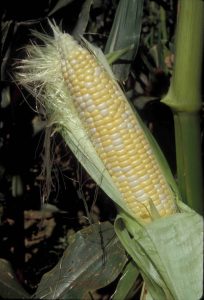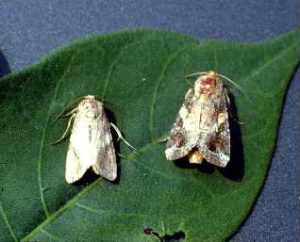Sweet Corn IPM Newsletter No. 13 – September 15, 2017
 Sweet Corn IPM Newsletter No. 13 – September 15, 2017
Sweet Corn IPM Newsletter No. 13 – September 15, 2017
Click on photos to enlarge.
Last Issue for 2017!
INCREASING PEST PRESSURE TO END SEASON
Fresh Silking Corn Remaining Likely to Need Protection
This will be the final issue of the Sweet Corn IPM Newsletter for the 2017 season. I would like to thank all of the growers who participated in the program this year, and our team of IPM scouts, including Kara Rowley, Tammy Cushman, Lindsey Ridlon and Sean McAuley. Have questions, comments or suggestions about the program? Please call or e-mail us.
SITUATION
It appears the tropical fronts and warmer weather pushing through Maine have only brought about a moderate increase in moth activity. There may be more activity associated with tropical storms in the coming weeks, however, so the threat to any fresh silking corn that still remains may increase.
European corn borer: No moth captures for a second week, so no real threat from European corn borer to end the season. There was no fresh larval feeding injury on younger corn and no sprays for this insect were recommended.
- Corn Earworm Moth; photo by David Handley
- Fall Armyworm Moths (female right, male left); photo by James Dill
Corn earworm: Moth counts rose moderately in most locations this week, keeping most fields with any fresh silk remaining on a spray schedule. A 6-day spray interval was recommended for silking corn in Oxford and one Wells site this week. A 5-day spray schedule was recommended in Auburn, one Dayton site and Sabattus. A 4-day spray interval was recommended in Cape Elizabeth, one Dayton location, North Berwick, and one Wells site.
Fall armyworm: Moth activity was spotty around the state this week, with some sites seeing a slight increase in activity and others not. No sprays were recommended exclusively for fall armyworm on silking corn, because all sites over the 3-moth threshold were on a spray interval for corn earworm, including Cape Elizabeth, Dayton, Oxford and Sabattus. No sites were over the 15% injury threshold for larval feeding damage.
Just a reminder that fall is a great time for soil testing
Late summer and early fall are good times to seed cover crops to prevent soil erosion and to retain soil nutrients. It is also a great time to check on the health of your soil. Getting your soil test results before the ground freezes allows time to correct soil pH with additions of lime, and incorporate any needed supplements into the soil, such as phosphorus, potassium, magnesium or other nutrients to correct deficiencies, and/or manure to increase organic matter. Fall applications of lime and some nutrients (not nitrogen, as it is prone to leaching) are often better, because the fields are drier than in the spring. It’s easier to move equipment around, and the nutrients will have time to be worked into the soil before the plants need them. You can pick up soil test boxes and forms at any county office of the University of Maine Cooperative Extension, or call us here at Highmoor Farm if you’d like us to send you some. For details on soil testing, visit the University of Maine Analytical Laboratory and Soil Testing Service website.
The New England Vegetable and Fruit Conference will be held in Manchester, New Hampshire on December 12, 13 and 14, 2017. Program and registration information will be coming soon. Visit the website.
Sincerely,
David T. Handley
Vegetable and Small Fruit Specialist
Highmoor Farm, P.O. Box 179, 52 US Route 202, Monmouth, ME 04259, 207.933.2100
UMaine Extension Diagnostic Research Lab, Pest Management Unit, 17 Godfrey Drive, Orono, ME 04473, 1.800.287.0279
| Location | CEW Moths |
ECB Moths |
FAW Moths |
%Feeding Damage |
Recommendations / Comments |
|---|---|---|---|---|---|
| Auburn | 5 | 0 | 0 | 5-day spray interval recommended on all silking corn | |
| Bowdoinham | 1 | 0 | 0 | 0% | No spray recommended |
| Cape Elizabeth I | 26 | 0 | 17 | 4-day spray interval recommended on all silking corn | |
| Cape Elizabeth II | 16 | 0 | 13 | 0% | 4-day spray interval recommended on all silking corn |
| Dayton I | 63 | 0 | 13 | 0% | 4-day spray interval recommended on all silking corn |
| Dayton II | 6 | 0 | 4 | 5-day spray interval recommended on all silking corn | |
| Monmouth | 1 | 0 | 1 | 0% | No spray recommended |
| North Berwick | 11 | 0 | 2 | 4-day spray interval recommended on all silking corn | |
| Oxford | 3 | 0 | 9 | 6-day spray interval recommended on all silking corn | |
| Sabattus | 5 | 0 | 4 | 5-day spray interval recommended on all silking corn | |
| Wales | 1 | 0 | 1 | 0% | No spray recommended |
| Wayne | 0 | 0 | 0 | No spray recommended | |
| Wells I | 2 | 0 | 2 | 6-day spray interval recommended on all silking corn | |
| Wells II | 10 | 0 | 0 | 4-day spray interval recommended on all silking corn |
CEW: Corn earworm (Only fresh silking corn should be sprayed for this insect.)
ECB: European corn borer
FAW: Fall armyworm
| Moths caught per week | Moths caught per night | Spray interval |
|---|---|---|
| 0.0 to 1.4 | 0.0 to 0.2 | No spray |
| 1.5 to 3.5 | 0.3 to 0.5 | Spray every 6 days |
| 3.6 to 7.0 | 0.6 to 1.0 | Spray every 5 days |
| 7.1 to 91 | 1.1 to 13.0 | Spray every 4 days |
| More than 91 | More than 13 | Spray every 3 days |
Thresholds apply only to corn with exposed fresh silk. Lengthen spray intervals by one day if maximum daily temperature is less than 80°F.
European Corn Borer Thresholds
Whorl stage: 30% or more of plants scouted show injury.
Pre-tassel-silk: 15% or more of plants scouted show injury.
Silk: 5 or more moths caught in pheromone traps in one week.
IPM Web Pages:
UMaine Cooperative Extension Integrated Pest Management
Penn State Pest Watch for Sweet Corn
UMass Amherst Integrated Pest Management
Where brand names or company names are used, it is for the reader’s information. No endorsement is implied nor is any discrimination intended against other products with similar ingredients. Always consult product labels for rates, application instructions and safety precautions. Users of these products assume all associated risks.
The University of Maine is an equal opportunity/affirmative action institution.


